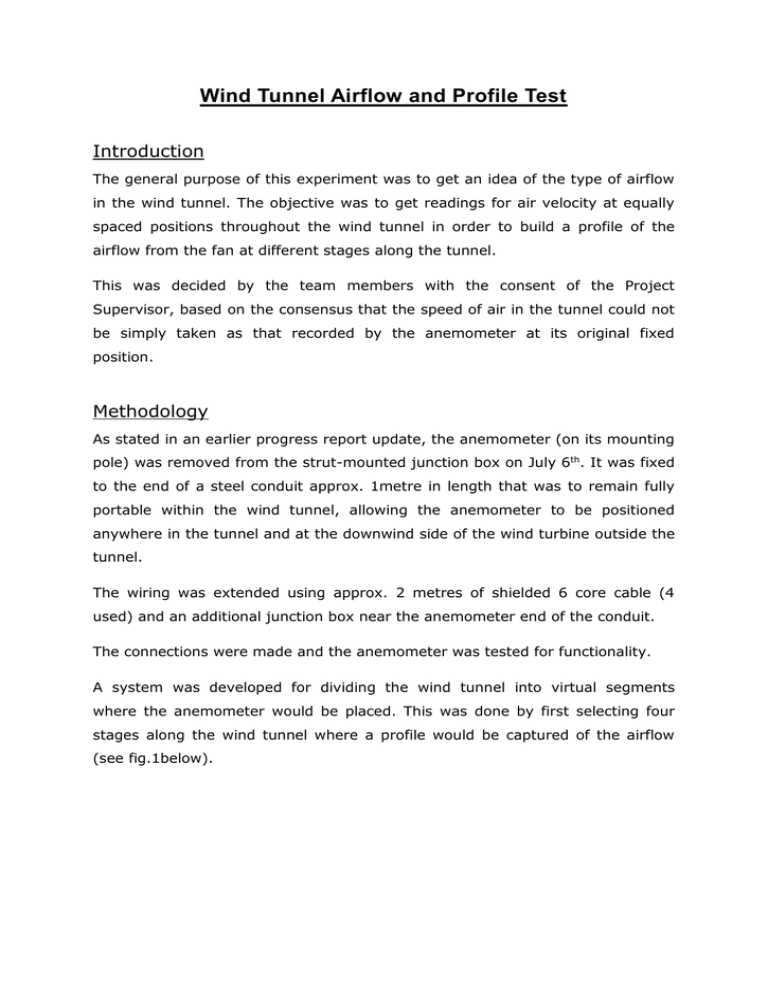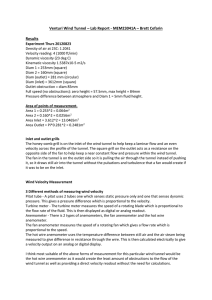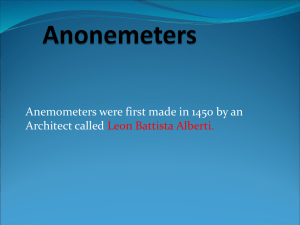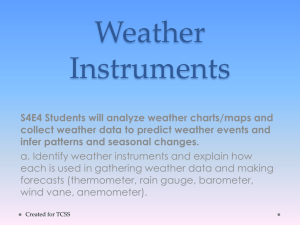Wind Tunnel airflow and profile report
advertisement

Wind Tunnel Airflow and Profile Test Introduction The general purpose of this experiment was to get an idea of the type of airflow in the wind tunnel. The objective was to get readings for air velocity at equally spaced positions throughout the wind tunnel in order to build a profile of the airflow from the fan at different stages along the tunnel. This was decided by the team members with the consent of the Project Supervisor, based on the consensus that the speed of air in the tunnel could not be simply taken as that recorded by the anemometer at its original fixed position. Methodology As stated in an earlier progress report update, the anemometer (on its mounting pole) was removed from the strut-mounted junction box on July 6th. It was fixed to the end of a steel conduit approx. 1metre in length that was to remain fully portable within the wind tunnel, allowing the anemometer to be positioned anywhere in the tunnel and at the downwind side of the wind turbine outside the tunnel. The wiring was extended using approx. 2 metres of shielded 6 core cable (4 used) and an additional junction box near the anemometer end of the conduit. The connections were made and the anemometer was tested for functionality. A system was developed for dividing the wind tunnel into virtual segments where the anemometer would be placed. This was done by first selecting four stages along the wind tunnel where a profile would be captured of the airflow (see fig.1below). Fig.1: side view of the wind tunnel with virtual divisions for airflow profiling. Then each profile was broken into nine equal segments representing a crosssectional view of the wind tunnel at that stage (see fig. 2 below) Fig. 2: layout of the anemometer positions for each profile as viewed from the Turbine end. The signal on pin 6 of the D connector of the Power Monitor was to be measured with reference to pin 2 (ground) to infer the wind speed at the anemometer. This signal, being a variable frequency square wave, was recorded using the Picoscope program on the lab PC. The anemometer was held in Position 1 at Profile stage 1 while the fan was turned on and its Variable Speed Drive increased to 50Hz output. A screenshot of the square wave representing the anemometer speed was captured and saved along with the Time/Div scale for frequency calculation later. This was repeated for all nine positions at each of the four profile stages inside and outside the wind tunnel. The output of the VSD was reduced to 30Hz and the procedure was repeated for the purpose of comparison. The fan was shut down and the screenshots were viewed to calculate the frequency of the square wave from the anemometer at each position. Results Square Wave Frequency (Hz) 50Hz Profile 1 30Hz Profile 1 0 19.04 15.38 4 14 10.3 27.5 1.09 1.15 22.2 3.5 4.4 20 5.46 26.7 0 8.6 23.9 50Hz Profile 2 30Hz Profile 2 16 5.5 9 12 5.9 8.5 13 4.8 2.5 9.7 3.8 0 14.4 10.5 2.3 13 7.2 0 50Hz Profile 3 30Hz Profile 3 13.2 7.2 4 8 5.7 5.8 11.4 2.3 3.8 6.7 1.5 2.56 14.4 8.2 6.5 12.1 5.8 4.5 50Hz Profile 4 30Hz Profile 4 10 5.86 10.3 9.8 4.7 6.5 8.3 5 4.4 7.5 2.6 4.2 6.4 7 3.8 8 6.6 2.6 Observations It was noticed, both from the anemometer movement and the signal generated, that at certain positions the anemometer stalled. This was most common at profile stage 1 (nearest the fan) and close to the edges of the wind tunnel, suggesting swirls or turbulence in the airflow as the air exited the fan assembly duct. It was seen that the wind speed was more evenly distributed across all positions for profiles 3 and 4 suggesting that the flow became less turbulent as it progressed down the tunnel. The wind speed was also observed to be low directly in front of and behind the nacelle of the turbine which was expected. Conclusions These readings are simply square wave frequency measurements and must be translated into metres/second wind speeds. This will be done when the Power Monitor is connected to the PC using the Data logger and the labVIEW software. However, using a method commonly employed for calculating wind speed from an anemometer’s rotation speed, the revolutions per second of the anemometer multiplied by its circumference (in metres) provides a range of wind speeds, in metres per second, that are in line with those inferred from the data sheet of the fan and the charging current of the wind turbine.





